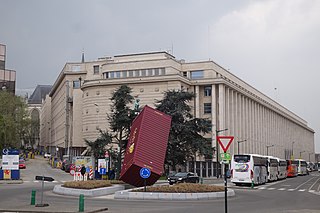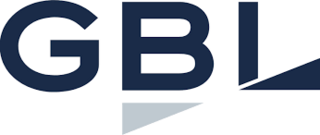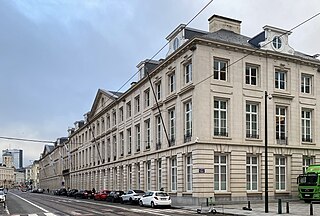
The National Bank of Belgium is the Belgian member of the Eurosystem. It was established by a law of 5 May 1850 and has been the monetary authority for Belgium from then until 1998, issuing the Belgian franc.

Groupe Bruxelles Lambert (GBL) is a Belgian holding company invested in multiple industries. It invests in both listed and private companies. Directed by Ian Gallienne, GBL had a net asset value of €22.5 billion and a market capitalisation of €15.3 billion at the end of September 2021.

The Société générale de Belgique was an investment bank and, subsequently, an industrial and financial conglomerate in Belgium between 1822 and 2003. The banking element was split in 1935 and became Générale de Banque. At its height in the late 19th and early 20th centuries, the Société Générale exercised significant control over large portions of the national economy of Belgium and the Belgian colonial empire.

The Générale de Banque was a major Belgian bank, created in 1934 as a spin-off from the powerful financial conglomerate Société Générale de Belgique (SGB) in compliance with new Belgian legislation that mandated separation of commercial banking activities from investment holdings. It was initially named the Banque de la Société Générale de Belgique, then from 1965 to 1985 the Société Générale de Banque. Upon establishment, it was the dominant bank in Belgium, with one-third of total banking assets, not counting other SGB-linked banking entities such as the Banque d'Anvers and the Banque Italo-Belge.
Baron Jean Godeaux was a Belgian economist, civil servant and former governor of the National Bank of Belgium (NBB) from 1982 until 1989.

ING Vysya Bank was a privately owned Indian multinational bank based in Bangalore, with retail, wholesale, and private banking platforms formed from the 2002 purchase of an equity stake in Vysya Bank by the Dutch ING Group. This merger marked the first between an Indian bank and a foreign bank. Prior to this transaction, Vysya Bank had a seven-year-old strategic alliance and shareholding arrangement with erstwhile Belgian bank Banque Bruxelles Lambert, which was also acquired by ING Group in 1998.
The Union Zaïroise de Banques (UZB), known before 1971 as the Banque Belge d'Afrique and after 2005 as the Union des Banques Congolaises, was a bank based in Kinshasa. It was established in 1929 by Belgium's Banque de Bruxelles as its main African banking affiliate, and remained majority-owned by European banks until nationalization in 1995. Its activities were liquidated in the early 2010s.
The Antwerp Diamond Bank, created in 1934 and known during its first few years as Comptoir Diamantaire Anversois, was a small bank that specialized exclusively in serving the diamond and the diamond-jewelry industry. In addition to its headquarters in Antwerp, it had offices covering major traditional as well as emerging diamond centers such as Dubai, Geneva, Hong Kong, Mumbai, and New York. In 1999, ADB became a wholly owned subsidiary of KBC Bank, and in 2014 it was wound down after a sale process to the Chinese Yinren Group failed.

The Banque de Bruxelles was a prominent bank in Brussels, established in 1871 and merged in 1975 with Banque Lambert to form Banque Bruxelles Lambert. It was Belgium's second-largest bank for most of its existence, behind the Société Générale de Belgique and, from 1934 onwards, its spun-off banking subsidiary.

The Banque Lambert was a significant family-controlled bank in Belgium, with roots going back to 1835 and long associated with the Rothschilds. It merged in 1975 with Banque de Bruxelles to form Bank Brussels Lambert, which itself was acquired in 1998 by ING Group.
Empain-Schneider was a Franco-Belgian industrial group formed in the 1960s from the merger of Belgium's Empain group and France's Schneider & Cie. In 1980 it was renamed Schneider SA. Throughout the 1980s and 1990s, the group was comprehensively restructured and sold most of its historic activities while acquiring operations linked to electrical equipment, leading up to its renaming in 1999 as Schneider Electric.

The Dépôt Joseph Cuvelier of the Belgian State Archives opened in 2011. It is located on the Rue du Houblon in Brussels in a building designed by Fernand Bodson and built in 1912. Its name honors Belgian historian and government archivist Joseph Cuvelier (1869–1947).
Events in the year 1975 in Belgium.
Léon Lambert, 3rd Baron Lambert was a Belgian banker and art collector.

The Algemene Spaar- en Lijfrentekas / Caisse générale d'épargne et de retraite was a major Belgian public bank, originally created in 1850 as a pension institution. It was acquired in stages between 1993 and 1998 by Fortis Group. In 1999 Fortis merged it with Générale de Banque and other operations to form Fortis Bank, which in turn was integrated from 2009 into BNP Paribas.

The Banque d'Outremer, initially known as the Compagnie Internationale pour le Commerce et l'Industrie (CICI) was a Belgian financial institution, established in 1899 in the context of the exploitation of the Congo Free State, and eventually merged into the Société Générale de Belgique in 1928.

The Caisse Générale de Reports et de Dépôts was a bank headquartered in Brussels, Belgium. Founded in 1874, its business was reorganized in 1940 under the new name Banque de Reports et de Dépôts (BRD). It was eventually absorbed in 1953 by the Banque Lambert.

The Société Belge de Banque was a medium-sized Belgian bank, established in 1901 as the Banque Générale Belge, renamed in 1932, and eventually merged in 1965 into the Société Générale de Banque.

The Crédit Communal de Belgique was a Belgian financial institution, established in 1860 and eventually merged with Crédit Local de France in 1996 to form Dexia. By the mid-1990s, it was the second-largest Belgian bank by total assets and the largest one by deposits.

The Banque de Commerce was a medium-sized Belgian bank. It was founded in Antwerp in 1780 by Charles Jean Michel De Wolf and was known as the Banque De Wolf until 1893. Just before World War I, it was the sixth-largest bank by total assets in Antwerp, and before World War II, the second-largest.














